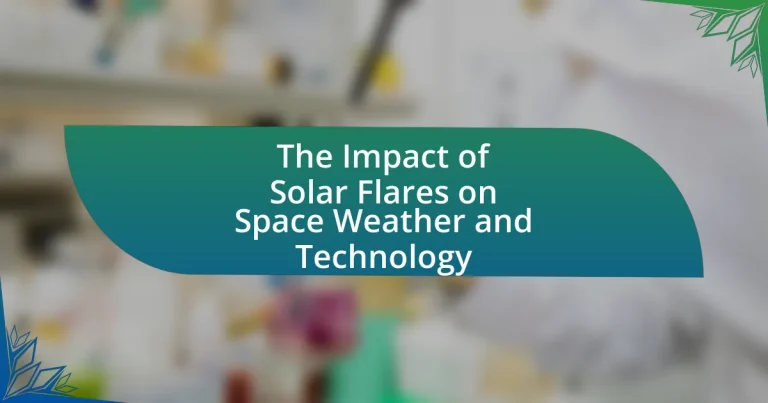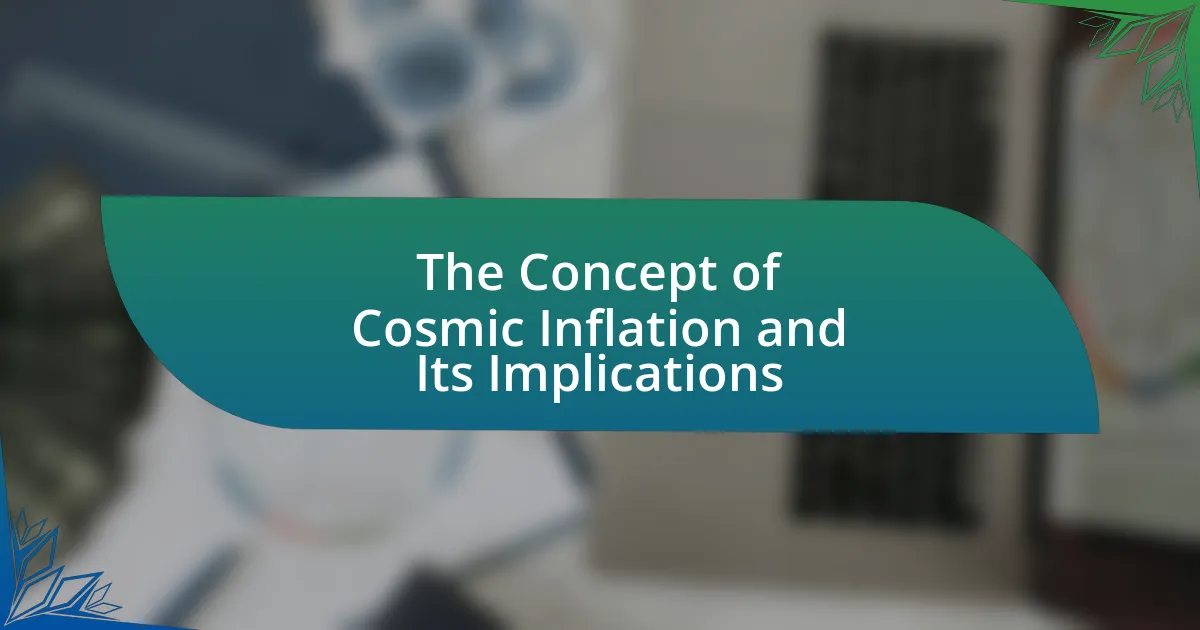Solar flares are intense bursts of radiation resulting from the release of magnetic energy associated with sunspots, significantly impacting space weather and technology on Earth. This article explores the characteristics, formation, and classification of solar flares, detailing their potential effects on communication systems, navigation, and power grids. It highlights the relationship between solar flares and geomagnetic storms, emphasizing historical events that demonstrate their disruptive capabilities. Additionally, the article discusses strategies for mitigating the impacts of solar flares on technology, including protective measures for satellites and electrical infrastructure.

What are Solar Flares and Their Characteristics?
Solar flares are intense bursts of radiation originating from the release of magnetic energy associated with sunspots. These phenomena can emit energy across the electromagnetic spectrum, including X-rays and ultraviolet light, and can last from minutes to hours. Solar flares are classified into categories based on their X-ray brightness, with A, B, C, M, and X classes, where X-class flares are the most powerful. The characteristics of solar flares include their rapid onset, high energy output, and potential to disrupt communication and navigation systems on Earth due to the associated increase in solar wind and radiation. Historical data shows that significant solar flares can lead to geomagnetic storms, impacting satellite operations and power grids, as evidenced by the Carrington Event of 1859, which caused widespread telegraph outages.
How do solar flares form?
Solar flares form when magnetic energy that has built up in the solar atmosphere is suddenly released. This release occurs in regions of intense magnetic activity, particularly near sunspots, where magnetic field lines become twisted and tangled. When these magnetic field lines reconnect, they release energy in the form of electromagnetic radiation, including X-rays and ultraviolet light, which can significantly impact space weather and technology on Earth.
What role do sunspots play in the formation of solar flares?
Sunspots play a crucial role in the formation of solar flares by serving as regions of intense magnetic activity on the Sun’s surface. These areas are characterized by strong magnetic fields that can become twisted and tangled due to the Sun’s rotation and convection processes. When the magnetic energy stored in sunspots is released suddenly, it can lead to the explosive outburst known as a solar flare. Research indicates that approximately 80% of solar flares originate from sunspot regions, highlighting their significance in flare activity. This relationship underscores the importance of monitoring sunspots to predict solar flares and their potential impacts on space weather and technology.
What are the different types of solar flares?
There are three main types of solar flares: Class A, Class B, Class C, Class M, and Class X. Each class is defined by its peak brightness in X-rays, with Class A being the weakest and Class X being the strongest. Class A flares have a peak brightness of less than 10^-7 watts per square meter, while Class X flares exceed 10^-4 watts per square meter. The classification system indicates the potential impact of these flares on space weather and technology, with higher classes correlating to more intense solar activity and greater potential for disruption to satellite communications and power grids.
What are the key measurements used to classify solar flares?
The key measurements used to classify solar flares are their intensity, duration, and spectral characteristics. Intensity is measured in terms of X-ray flux, categorized into classes such as A, B, C, M, and X, with each class representing a tenfold increase in energy output. Duration refers to the time a flare lasts, which can range from minutes to hours, influencing its potential impact on space weather. Spectral characteristics involve analyzing the wavelengths of emitted radiation, providing insights into the flare’s temperature and energy levels. These measurements are critical for understanding the potential effects of solar flares on space weather and technology.
How is the intensity of a solar flare measured?
The intensity of a solar flare is measured using instruments that detect electromagnetic radiation across various wavelengths, including X-rays, ultraviolet, and radio waves. These measurements are typically conducted by satellites equipped with specialized sensors, such as the Solar Dynamics Observatory and the Geostationary Operational Environmental Satellites, which provide real-time data on the flare’s energy output. The intensity is quantified in terms of flux, which represents the amount of energy emitted per unit area, allowing scientists to assess the flare’s strength and potential impact on space weather and technology.
What are the scales used to categorize solar flares?
The scales used to categorize solar flares are the X-ray classification system, which includes A, B, C, M, and X classes. Each class represents a range of X-ray brightness, with A being the weakest and X being the strongest. For instance, an X-class flare is at least ten times more powerful than a C-class flare. This classification system is based on measurements taken by satellites, such as the GOES (Geostationary Operational Environmental Satellites), which monitor solar activity and provide data on flare intensity.

How do Solar Flares Affect Space Weather?
Solar flares significantly affect space weather by releasing vast amounts of energy and charged particles into the solar system. These eruptions can disrupt the Earth’s magnetosphere, leading to geomagnetic storms that can impact satellite operations, communication systems, and power grids. For instance, the solar flare on March 13, 1989, caused a geomagnetic storm that resulted in a nine-hour blackout in Quebec, Canada, demonstrating the tangible effects of solar flares on technology and infrastructure.
What is the relationship between solar flares and space weather phenomena?
Solar flares are intense bursts of radiation from the sun that significantly influence space weather phenomena. These flares release large amounts of energy and charged particles into space, which can interact with the Earth’s magnetosphere, leading to various space weather effects such as geomagnetic storms and solar energetic particle (SEP) events. For instance, the 1989 geomagnetic storm, triggered by a solar flare, caused widespread power outages in Quebec, demonstrating the direct impact of solar flares on technological systems.
How do solar flares influence geomagnetic storms?
Solar flares influence geomagnetic storms by releasing vast amounts of energy and charged particles into space, which interact with Earth’s magnetic field. When a solar flare occurs, it can accelerate electrons and protons, creating a coronal mass ejection (CME) that travels toward Earth. Upon reaching Earth, these charged particles can disturb the magnetosphere, leading to geomagnetic storms. Historical data shows that significant solar flares, such as the Carrington Event of 1859, resulted in intense geomagnetic storms that caused widespread disruptions to telegraph systems. This demonstrates the direct correlation between solar flare activity and the intensity of geomagnetic storms.
What effects do solar flares have on the Earth’s ionosphere?
Solar flares significantly affect the Earth’s ionosphere by causing rapid changes in its density and composition. These intense bursts of radiation from the sun can lead to increased ionization in the ionosphere, which can disrupt radio communications and navigation systems. For instance, during solar flare events, the ionosphere can experience sudden enhancements in electron density, leading to phenomena such as radio blackouts and GPS inaccuracies. Historical data from events like the 1989 solar flare demonstrate that such disruptions can last from minutes to hours, impacting both civilian and military operations reliant on radio frequencies.
What are the potential impacts of solar flares on satellites and spacecraft?
Solar flares can significantly disrupt satellites and spacecraft by causing radiation exposure, communication interference, and damage to electronic components. The intense bursts of electromagnetic radiation and charged particles emitted during solar flares can lead to increased radiation levels in space, which can harm satellite electronics and degrade their performance. For instance, the 1989 solar flare event caused a temporary loss of communication with several satellites and impacted the power grid in Quebec, demonstrating the potential for widespread disruption. Additionally, solar flares can induce geomagnetic storms that affect satellite orbits and navigation systems, leading to inaccuracies in positioning data.
How can solar flares disrupt satellite communications?
Solar flares can disrupt satellite communications by emitting intense bursts of electromagnetic radiation and charged particles that interfere with radio signals and satellite electronics. These flares can cause radio blackouts, particularly in high-frequency bands, as the ionosphere becomes disturbed, leading to signal degradation or loss. For instance, the X-class solar flares, which are the most powerful, can produce significant disruptions lasting from minutes to hours, affecting global communication networks. Historical data shows that the solar flare on March 13, 1989, caused widespread radio communication failures and even led to a power grid collapse in Quebec, demonstrating the tangible impact of solar activity on technology.
What measures can be taken to protect spacecraft from solar flares?
To protect spacecraft from solar flares, engineers can implement shielding techniques, utilize advanced materials, and develop operational protocols. Shielding techniques, such as using thick layers of aluminum or polyethylene, can absorb and deflect harmful radiation. Advanced materials, like specialized composites, can enhance protection against energetic particles. Additionally, operational protocols, including real-time monitoring of solar activity and adjusting spacecraft orientation during solar events, can minimize exposure. Historical data from missions like the Solar and Heliospheric Observatory (SOHO) demonstrate that these measures effectively reduce radiation risks to spacecraft systems.

What is the Impact of Solar Flares on Technology?
Solar flares can significantly disrupt technology by causing electromagnetic interference that affects satellite operations, communication systems, and power grids. For instance, during intense solar flare events, satellites may experience malfunctions or damage due to increased radiation levels, leading to loss of data or operational capabilities. Additionally, solar flares can induce geomagnetic storms that result in voltage fluctuations in power lines, potentially causing transformer damage and widespread power outages. Historical events, such as the 1989 geomagnetic storm caused by solar activity, resulted in a nine-hour blackout in Quebec, Canada, illustrating the tangible impact of solar flares on technological infrastructure.
How do solar flares affect power grids and electrical systems?
Solar flares can disrupt power grids and electrical systems by inducing geomagnetic storms that create fluctuations in the Earth’s magnetic field. These fluctuations can lead to voltage instability, transformer damage, and even widespread blackouts. For instance, the 1989 geomagnetic storm caused by a solar flare resulted in a nine-hour blackout in Quebec, affecting millions of people. Additionally, the National Oceanic and Atmospheric Administration (NOAA) has reported that strong solar flares can generate currents in power lines, which can overload transformers and lead to failures. Thus, solar flares pose a significant risk to the reliability and safety of electrical infrastructure.
What are the risks of solar flares to electrical infrastructure?
Solar flares pose significant risks to electrical infrastructure by inducing geomagnetic storms that can disrupt power grids. These storms can cause voltage fluctuations, transformer damage, and even widespread blackouts. For instance, the 1989 geomagnetic storm caused a nine-hour blackout in Quebec, affecting millions and resulting in an estimated $6 billion in damages. Additionally, the National Oceanic and Atmospheric Administration (NOAA) has reported that severe solar events can lead to increased currents in power lines, which can overload systems and damage equipment.
How can utilities prepare for solar flare events?
Utilities can prepare for solar flare events by implementing robust grid protection measures and enhancing monitoring systems. These preparations include investing in advanced forecasting technologies to predict solar activity, which allows utilities to take proactive steps to safeguard infrastructure. For instance, the National Oceanic and Atmospheric Administration (NOAA) provides space weather alerts that can inform utilities about potential solar flare impacts. Additionally, utilities can strengthen their electrical grids by installing surge protectors and reinforcing transformers to withstand geomagnetic induced currents (GICs) caused by solar flares. Historical data shows that the 1989 geomagnetic storm, triggered by a solar flare, caused widespread power outages in Quebec, highlighting the importance of these preparations.
What are the implications of solar flares for aviation and GPS technology?
Solar flares can significantly disrupt aviation and GPS technology by causing radio communication blackouts and navigation inaccuracies. These solar events emit high-energy particles and electromagnetic radiation that can interfere with the ionosphere, leading to degraded performance of GPS signals and potential loss of communication for aircraft. For instance, during the solar flare event in March 1989, a major disruption occurred, affecting radio communications for flights over the North Atlantic. Additionally, the Federal Aviation Administration (FAA) has reported that solar flares can lead to increased radiation exposure for pilots and passengers on high-altitude flights, necessitating flight path adjustments during periods of heightened solar activity.
How do solar flares impact aviation safety?
Solar flares can significantly impact aviation safety by disrupting communication and navigation systems. These solar events release bursts of electromagnetic radiation and charged particles that can interfere with high-frequency radio communications, essential for aircraft operations, especially over oceans and remote areas. For instance, during a solar flare event in 1989, pilots reported communication blackouts, which posed risks to flight safety. Additionally, increased radiation exposure at high altitudes can affect crew and passenger health, particularly on polar routes where the Earth’s magnetic field offers less protection. Studies have shown that airlines may reroute flights or adjust altitudes during solar flare events to mitigate these risks, demonstrating the direct influence of solar activity on aviation safety.
What effects do solar flares have on GPS accuracy?
Solar flares can significantly degrade GPS accuracy by causing ionospheric disturbances. These disturbances lead to increased signal delay and multipath effects, which can result in positioning errors of several meters. Research indicates that during intense solar flare events, the total electron content in the ionosphere can increase dramatically, affecting the propagation of GPS signals. For instance, a study published in the Journal of Geophysical Research found that GPS positioning errors can exceed 10 meters during strong solar activity, illustrating the direct impact of solar flares on GPS accuracy.
What strategies can be implemented to mitigate the effects of solar flares on technology?
To mitigate the effects of solar flares on technology, implementing robust shielding and protective measures for electronic systems is essential. This includes using Faraday cages to protect sensitive equipment from electromagnetic interference and enhancing satellite shielding to withstand increased radiation levels. Additionally, developing advanced forecasting models can help predict solar flare activity, allowing for timely shutdowns or adjustments in satellite operations to minimize damage. Historical data shows that during the 1989 geomagnetic storm, which was caused by solar activity, power grids in Quebec experienced widespread outages, highlighting the need for proactive measures.
What best practices should industries adopt to safeguard against solar flare impacts?
Industries should adopt several best practices to safeguard against solar flare impacts, including implementing robust shielding for electronic systems, enhancing monitoring of space weather, and developing contingency plans for communication disruptions. Shielding can involve using materials that absorb or deflect electromagnetic radiation, which helps protect sensitive equipment. Enhanced monitoring through partnerships with organizations like the National Oceanic and Atmospheric Administration (NOAA) allows industries to receive timely alerts about solar activity, enabling proactive measures. Additionally, having contingency plans ensures that operations can continue or quickly recover in the event of communication failures, as evidenced by the disruptions caused during the 1989 geomagnetic storm that affected power grids in Quebec.
How can technology be designed to withstand solar flare events?
Technology can be designed to withstand solar flare events by incorporating shielding materials, implementing redundancy in systems, and utilizing robust error-correction algorithms. Shielding materials, such as lead or specialized polymers, can protect sensitive electronics from increased radiation levels during solar flares. Redundancy ensures that if one system fails due to solar interference, backup systems can maintain functionality, as seen in satellite designs that often include multiple communication pathways. Error-correction algorithms can help mitigate data corruption caused by radiation, enhancing the reliability of data transmission during solar events. These strategies are supported by historical data, such as the 1989 geomagnetic storm that caused widespread power outages, highlighting the need for resilient technology in the face of solar activity.




